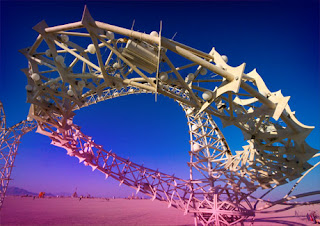Week One: Two Cultures
My name is Jen, and I am a firm
believer that I am caught in one of the two cultures. In “Toward a Third
Culture,” Professor Vesna wrote about what it means to create art, which she
defined as “bridging and synthesizing many worlds while composing “something
else”.” (Vesna 124) As a pre-med student, I think this may be my first class
where I’m asked to genuinely look at whether or not I create things. Most of my
work is memorization and regurgitation, something Brockman would describe as an
“ersatz reality.” (Brockman) While I thoroughly enjoy my major, I
often find that I’m never seeking out answers myself and my field falls under
the category of one without artistic research.
 |
| The artistic side of engineering. |
In “Two Cultures and the Scientific
Revolution,” Snow points out that the divides between groups can only grow, and
that the “common attitudes, common standards, and patterns of behavior” are
reinforced once a divide is mentioned. (Snow 10) I’ve found this to be true as
I navigate college, demonstrated in major ways like our campus layout and
architecture and minor ways that students divide themselves, like within the
UCLA memes page. However, I think at UCLA, engineers specifically may be the
"third culture” as described by Kevin Kelly in “The Third Culture.”
 | |
|
This course is relevant to me as I
embark on my endeavor to become a doctor. I think it’s vital to incorporate
different methods of thinking and embrace other intellectual fields, and my
ultimate goal is to become a part of the “third culture” without changing my
career path. To create something, whether it be new technology to help save
lives or a new system for patient hand-off in the ER, and better the experience
of my future patients would allow me to merge the different types of problem
solving that currently divide the two fields via a “just do it” attitude.
(Kelly)
Sources:
Brockman, John.
"John Brockman: Matchmaking with science and art." Interview by Duncan
Graham-Rowe. Wired UK. N.p., 3 Feb. 2011. Web.
Kelly, Kevin. "The Third
Culture." Science. American Association for the Advancement of
Science, 13 Feb. 1998. Web.
Snow, C.P. “The Two
Cultures and the Scientific Revolution” Cambridge Univ.
Press, New York, 1959.
Vesna, Victoria. Part II- Stereotypes
https://cole2.uconline.edu/courses/684222/pages/unit-1-view?module_item_id=11226133
Vesna, Victoria. "Toward a Third
Culture: Being In Between." Leonardo 34.2 (2001): 121-25.
Web.
Wilson, Stephen. “Myths and Confusions
in Thinking about Art/Science/Technology”. http://userwww.sfsu.edu/~swilson/
Pictures:
Holscher,
Mars. “Spot the differences: north campus vs
south campus.” Facebook. UCLA Memes for Sick AF Tweens. 20
March 2017. https://www.facebook.com/groups/163576114113950/permalink/243705129434381/?match=bm9ydGggY2FtcHVzIHZzIHNvdXRoIGNhbXB1cw%3D%3D
Prados, Michael.
"The Intersection of Art and Engineering." American Society
of Mechanical Engineers.
https://www.asme.org/engineering-topics/articles/construction-and-building/intersection-of-art-and-engineering
UCLA School of Dentistry. “Commitment
to World Class Research.”
https://www.dentistry.ucla.edu/researc



It is interesting that in your experience, pre-med is a field that involves much memorization and regurgitation of the material. As competitive as the pre-med track sounds, it seems like you are still quite passionate about the field and look forward to becoming a doctor in the future. I think the histogram shows an interesting yet stark contrast of the difficulty of courses between UCLA's North and South campuses. Why do you think that engineers (even though they are technically South campus) may be considered the "Third Culture" at UCLA? As an electrical engineering major myself, I found that UCLA's engineering curriculum focuses mainly on educating theory and less on the practical applications (unlike some schools like Cal Poly Pomona). Nevertheless, I agree with you that incorporating different ways of thinking and problem-solving are essential to creating a third culture that bridges the gaps between the arts and sciences.
ReplyDeleteHi Jeffrey!
DeleteI've found that it's entirely memorization so far, but that could simply be the "weeder"/pre-req/under-div classes. Whether that carries out into my junior and senior year is to be determined. I think engineers (or possibly even more "hard" sciences as opposed to "life" sciences) are a third culture because instead of simply regurgitating facts about, say, cells, I see my engineering friends given CS programming projects, creating circuits, and being assigned things where every student is answering the same question in a different way. While more technical, it almost seems like they need more creativity than people in my classes. However, I'm not in the classes so this is an entirely outside perspective!
I think it's admirable that you plan on incorporating different levels and methods of thinking into one of the majors that is most polarized in the science culture. When people think of the memorization and regurgitation involved in the study of medicine and medical school, they can often forget about the creativity and innovation that is extremely present in medicine, especially today when involving the third culture or "bridge" of technology. I am a Psychology major so I experience some of both the north and south campuses, and was just thinking today how I would have liked to have more mathematics and hard sciences incorporated in our curriculum, in order to really be trained in a multitude of areas, which you have elegantly described pursuing in your post!
ReplyDelete